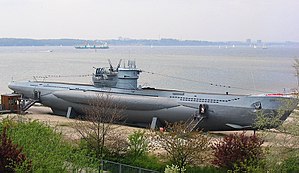 HNoMS Kaura (U-995) at the Laboe Naval Memorial | |
| Class overview | |
|---|---|
| Operators | |
| Built | 1940–1945 |
| In commission | 1948–1965 |
| Preserved | 1 |
| General characteristics | |
| Class and type | German Type VII submarine |
| Displacement |
|
| Length |
|
| Beam |
|
| Height | 9.6 m (31 ft 6 in) |
| Draft | 4.74 m (15 ft 7 in) |
| Propulsion |
|
| Speed |
|
| Range |
|
| Test depth | 250 m (820 ft) |
| Complement | 44-52 men |
| Armament |
|
The Norwegian K class submarines are a class of three submarines the Royal Norwegian Navy received from Germany in 1948 as Allied war spoils. They were built as the Type VIIC/41 U-boat from 1940 to 1945. The ships were named HNoMS Kya (ex-U-926), Kinn (ex-U-1202), and Kaura (ex-U-995). Kaura was returned to Germany in 1971 as a museum ship. It is the only surviving Type VII in the world.